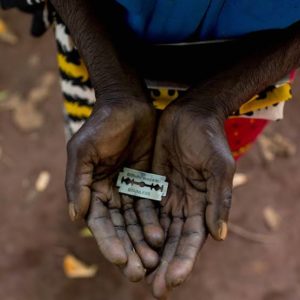Female genital mutilation or simply put, female circumcision is the act of removing parts or all of the female genitalia or any other part of the female genital organs for non-medically related reasons. It is done on females from birth to the age of 15 with peak age being 12/13years as this marks the peak of puberty for some girls. However, FGM in older women is not uncommon.
The World Health Organization has it that, more than 200 million girls and women alive today have been circumcised in 30 countries in Africa, the Middle East, and Asia where FGM is concentrated.

It would interest you to know that there are four (4) types of FGM depending on what part of the external genitalia is cut.
Type I: Partial or total removal of the clitoris and/or the prepuce;
Type II: Partial or total removal of the clitoris and the labia minora, with or without excision of the labia majora;
Type III: Narrowing of the vaginal orifice with creation of a covering seal by cutting and appositioning the labia minora and/or the labia majora, with or without excision of the clitoris (infibulation); and
Type IV: Unclassified all other harmful procedures to the female genitalia for non-medical purposes.

This is done using a sharp object like a razor blade, knife, etc. to cut off the intended part(s). It is believed to be done to control a woman’s sexuality and make her marriageable. The truth is, the clitoris (part of the female genitalia commonly cut) is a sensitive part of a woman’s vulva; its removal implies depriving a woman of sexual pleasure, low sexual drive, and ultimate loss of interest. If control of female sexuality and curtailing promiscuity is the aim, is this the only way?
Side Effects
The side effects, trauma, and psychological impacts are not considered by the perpetrators. Some are immediate while others are long-term.
Immediate side effects include:
• Severe pains
• Severe bleeding
• Infections of the wound and or the urinary tract
• Death
Long term effects would include:
• Post-traumatic stress disorder (PTSD)
• Painful intercourse
• Lack of sexual pleasure
• Anxiety
• Depression
• Low self-esteem
• Sexual phobias
• Marital problems
• Infertility (this depends on the extent of mutilation)

Thanks to advocacies and awareness programs that have been done to this effect, there is a progressive reduction in this practice but more can be done. Every female especially those in communities where this is still being practiced is still at risk.
What Is My Role And Yours?
• Participation in the International Day of Zero Tolerance for Female Genital Mutilation on the 6th of February every year.
• Educating everyone about female genital mutilation formally and informally; can be done by including it in the school curriculum and bedtime / folklores.
• Continuous advocacy for the principles of equity and non-discrimination based on sex, the right to life, and freedom from torture and cruel, inhuman, or degrading treatment or punishment.
• Use of other non-harmful ways of controlling sexuality such as teaching abstinence.
• Intentionally looking out for the wellbeing of any girl who is suddenly, anxious, afraid, withdrawn or, depressed.
• Reporting such practice to the appropriate authorities such as the ministry of women affairs
It is feared that an estimated 3 million girls are at risk of being cut yearly but the goal is to eradicate FGM by 2030 and it is possible; FGM MUST GO!



